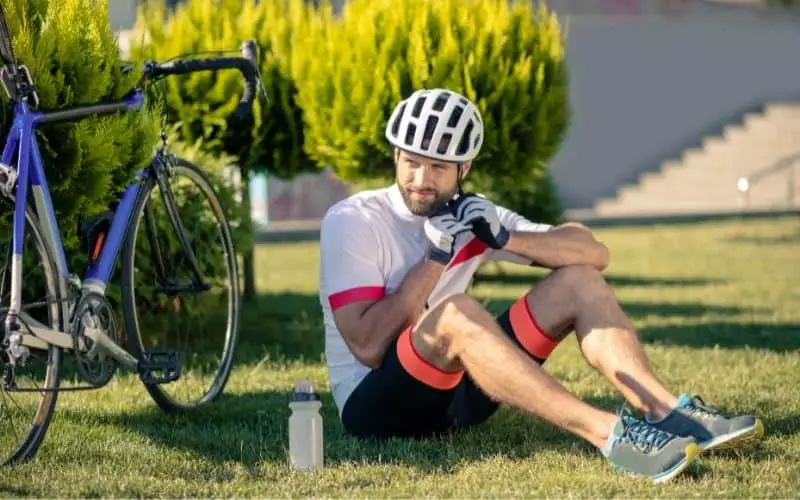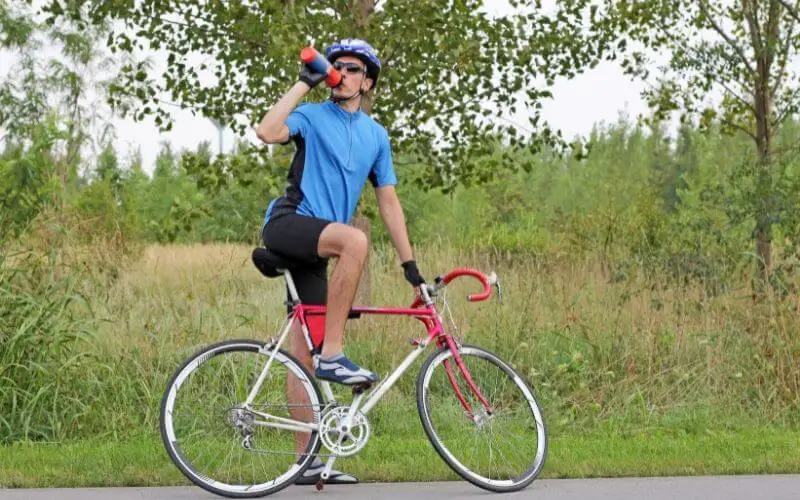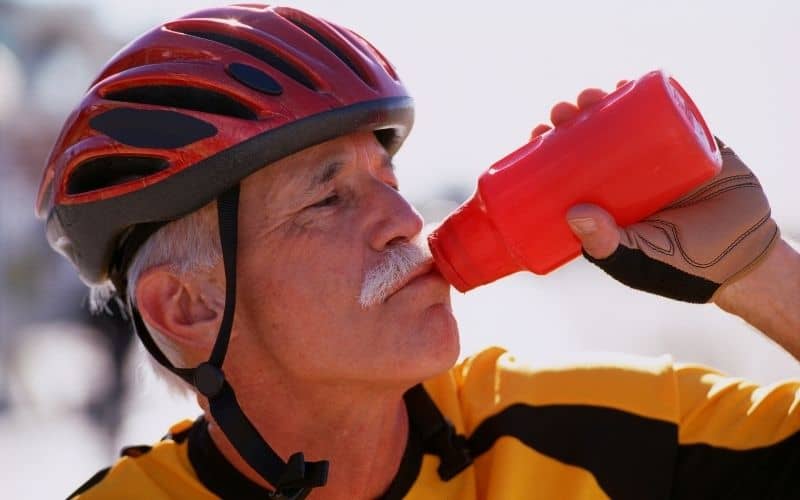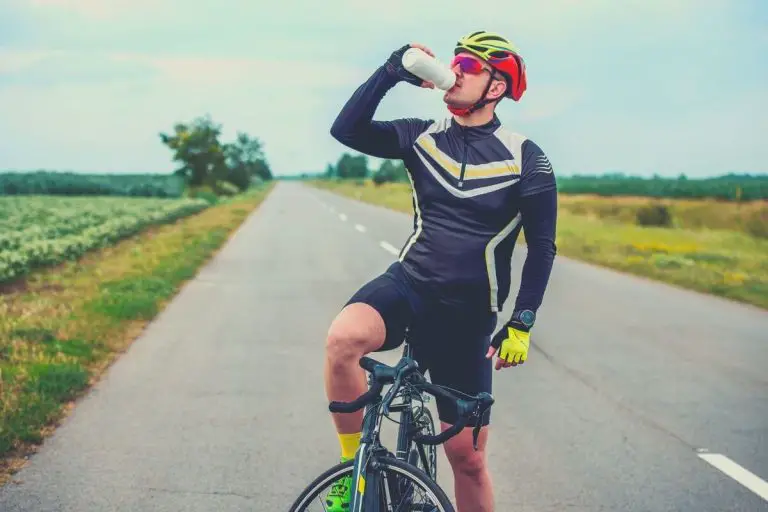If you’re like me you’ve experienced signs of dehydration when you’re on your bike. It took me a long time to learn how to prevent dehydration while cycling but I’m glad I did!
My performance is better and my recovery is better. Win all around.
Want to know my secret?
Keep reading 👍
If you are cycling regularly, you should drink water before, during, and after each workout. Dehydration occurs when the body loses too much fluid through sweating or other means. When you are well hydrated, it helps to avoid symptoms like fatigue or cramps.
Signs Of Dehydration And How To Fix It
There are a few telling signs that you’re becoming dehydrated, it’s good to be aware of them. Below are the key signs – learn them!
Racing Heart
As you get dehydrated, you may notice that your heart starts to spike. Dehydration causes blood volume to drop and that causes your blood to thicken.
The result?
Your heart isn’t able to supply fuel to your muscles. This causes your heart to work harder, which is why your heart rate increases.
Basically, your heart has to work harder to get the same amount of fuel to your muscles.
To fix this, you need to rehydrate as quickly as possible. Oral rehydration is the best solution in this instance but it should be more than just water. We lose more than just water, we’re losing electrolytes too so it’s vital that you replace those as well.
Adding an electrolyte-infused drink to your water bottle can help bring your levels back to normal and reduce your heart rate. However, if your heart rate is unusually high, I would recommend slowing the pace down for a while until it has calmed down.
Lightheaded And/Or Dizzy
Pretty fun fact, your brain is 80% water.
What that means is that even slight changes to your level of hydration can leave you feeling dizzy.
Losing electrolytes like sodium, potassium, and chloride does affect how your brain sends messages to your muscles and nerve cells.
In other words, your brain can’t work as well as it should. If you find that you do feel dizzy or lightheaded when you’re riding, firstly, stop riding. By not stopping, you’re putting yourself at risk of crashing or doing some serious damage to yourself.
Once you’ve stopped, it’s time to consider electrolytes. At that moment, your body has an imbalance of electrolytes and isn’t able to absorb fluids as usual.
One way to fix this quickly is to focus on getting sugar and sodium into your system. These help your body to deal with water and other electrolytes in the most effective way.
Related article – Best Cycling Hydration Drinks – Refuel Properly!

Pounding Headache
Headaches can come about from various different reasons but if you felt in a good place before you started your ride and you don’t now, there’s a high chance that dehydration is the cause.
What does dehydration do to the brain?
It causes the brain to shrink and pull away from the cranium. The pain receptors in the membrane around your brain get irritated, and this is what you know to be a headache.
The fix? Drink more.
If you have a dehydration headache, it does feel like a headache you’ll get when you’ve got a hangover. The remedy is much the same too! Over-the-counter pain relief and fluids!
Dry Looking Skin
The content of your skin is around two-thirds water.
As you become more dehydrated, your body tried to retain fluid and this causes your body temperature to rise.
The result of this is that your skin has a dry appearance. Your body is trying to ensure that the water you have left is going to your vital organs, your skin isn’t one of those so it gets less priority.
If you are at the point where your skin is looking dry, then you need to start to rehydrate immediately.
Pro-tip: Focus on pre-hydrating to avoid this, I tend to drink my favorite electrolyte around 12 hours before I’m due to go out on a long ride and this seems to prevent this issue.
Your Urine Is An Unusual Small Or Color
So your kidneys do their best to keep you dehydrated. They will flush out water when you have enough or keep hold of it when you’re showing signs of dehydration.
What you find when your body becomes dehydrated is that there is less water available to dilute the waste products so your urine becomes more concentrated and darker – usually more smelly too!
This is something that can be easily monitored throughout your ride. What you should be aiming for is clear urine or light straw color.
If you notice that your urine is starting to get darker then you need to drink more. If you drink more, you will notice that you’ll start to see a better color when you next go to the restroom.

Performance Drops With Mild Dehydration
It doesn’t take a lot of dehydration before you will start to notice a drop in your performance.
Studies have shown that losing only 2% of your body weight from sweating will lead to a noticeable drop in performance.
When you lose 4% of your body weight, your capacity for muscular work is decreased.
At 5%, heat exhaustion will start to become an issue. Not only that, your ability to perform will decrease by around 30%.
7% and you may experience hallucinations and when you get to 10% (don’t get to this point!), heatstroke and circulatory collapse become a possibility.
Tips To Avoid Dehydration
1. Drink First Thing
If you’re in for a warm day in the saddle, ensure that you drink 300 – 500 ml of water, first thing in the morning.
Personally, I find that a handy squeeze of lemon adds to it. It gives your metabolism a wake-up and helps to replace the water you have lost from sleep.
The lemon also gives you a boost of vitamin C, always a good thing!
2. Electrolytes
Use electrolytes! It has been shown that when riders only use water to rehydrate, it doesn’t replace your electrolytes, such as sodium, potassium, calcium, and magnesium – you will see a drop in your performance as a result, usually a dramatic one too!
Pro-tip: In the winter, use a stronger mix as you won’t be drinking as much so you’ll get a stronger mix of electrolytes. When summer hits, use a weaker mix as you’ll be drinking more.
3. Drink Before You Get Thirsty
A lot of people say that if you get thirsty when you’re riding a bike, you’ve left it too late, you’re already on the way to being dehydrated.
As you’re riding, take sips of water and electrolyte. I aim for around 1.25 liters per hour on really hot days.
Everyone is different with how much they need to keep at a well-hydrated level so find what works for you.
Whatever your level, keep sipping away!
4. Post Ride Nutrition
When you’ve finished your bike ride, be sure to replenish and hydrate. Water is not the only answer here!
I’m talking about replacing your protein, carbs, and electrolytes. Of course, drink water too.

Electrolyte Drink Vs Carbohydrate Drink
You have a choice when you’re deciding how best to stay hydrated on a ride and my top two choices are electrolyte drinks or carbohydrate drinks – which one is for you?
Electrolyte Drinks
These drinks are a mixture of water and electrolytes. The idea behind these drinks is to hydrate you, rather than provide fuel.
What you do find is often they have some levels of carbohydrates in them so you do also get a bit of fuel too.
Electrolytes are most suited for rides that last longer than an hour, are in hot weather, or for riders who prefer to fuel with food rather than liquid.
Carbohydrate Drinks
Carbohydrate drinks are a mixture of water, carbohydrates, and electrolytes.
You often find that these drinks are in powder form, and you mix them at home, allowing you to get the right blend for you and the type of ride you’re doing. There are a few different sources of carbohydrates, sucrose, glucose and, fructose.
Carbohydrates are stored in the muscles and liver as glycogen. They are the body’s preferred source of energy when you’re exercising.
When your glycogen levels start to decrease, you will find it harder to keep going. What a carbohydrate drink does is provide you with that energy and help to increase your endurance.
If you’re a rider who likes to drink for fuel, rather than eat, then carbohydrate drinks are the way to go.
Related article – Nutrition Tips For A Gran Fondo
Frequently Asked Questions
What should I drink after cycling?
Try to get some carbohydrates in when you’ve finished your ride, this can be in the form of powder to mix with water.
Depending on the length of the ride I have found that chocolate milk can help give me the required boost as it’s a good source of protein, carbs, and vitamins – plus it’s delicious!
Is Pouring Water Over You Effective?
Pouring water over you when you’re cycling can be effective at keeping you hydrated for longer but it has to be in the right conditions.
What you’re aiming for is for the water to stay on you long enough for it to evaporate, this helps to keep your body temperature more regulated, but only for a limited amount of time, it has to be said.
If the water simply runs off you, then all it has done is cool you down for a few seconds.
My advice? Drink most of it and maybe pour some over you. Though make sure it is only water you pour. Electrolytes leave you in a sticky state that bees and wasps find incredibly attractive!
You may also be interested in Best Hydration Backpacks For Cycling: Ditch The Water Bottle.

